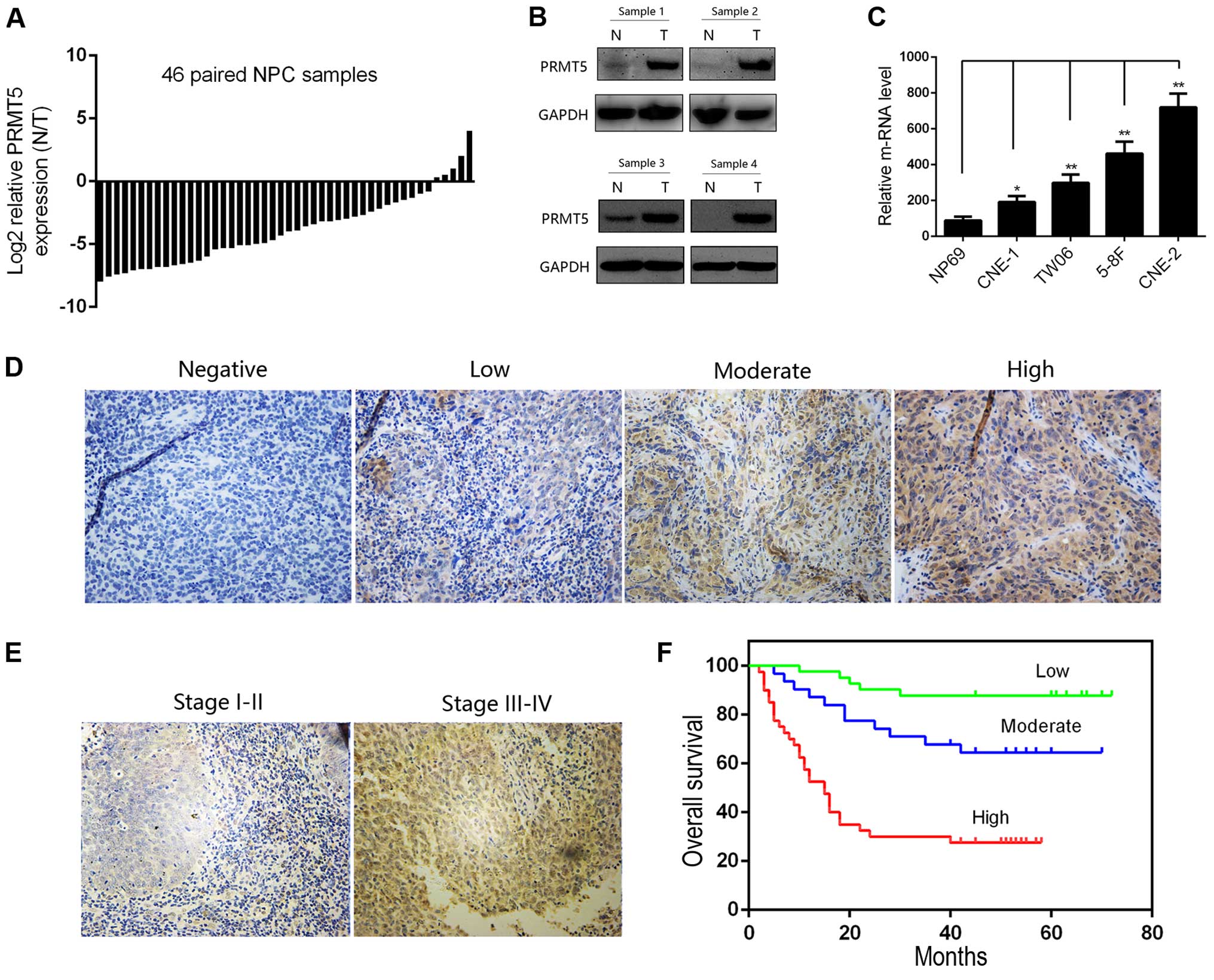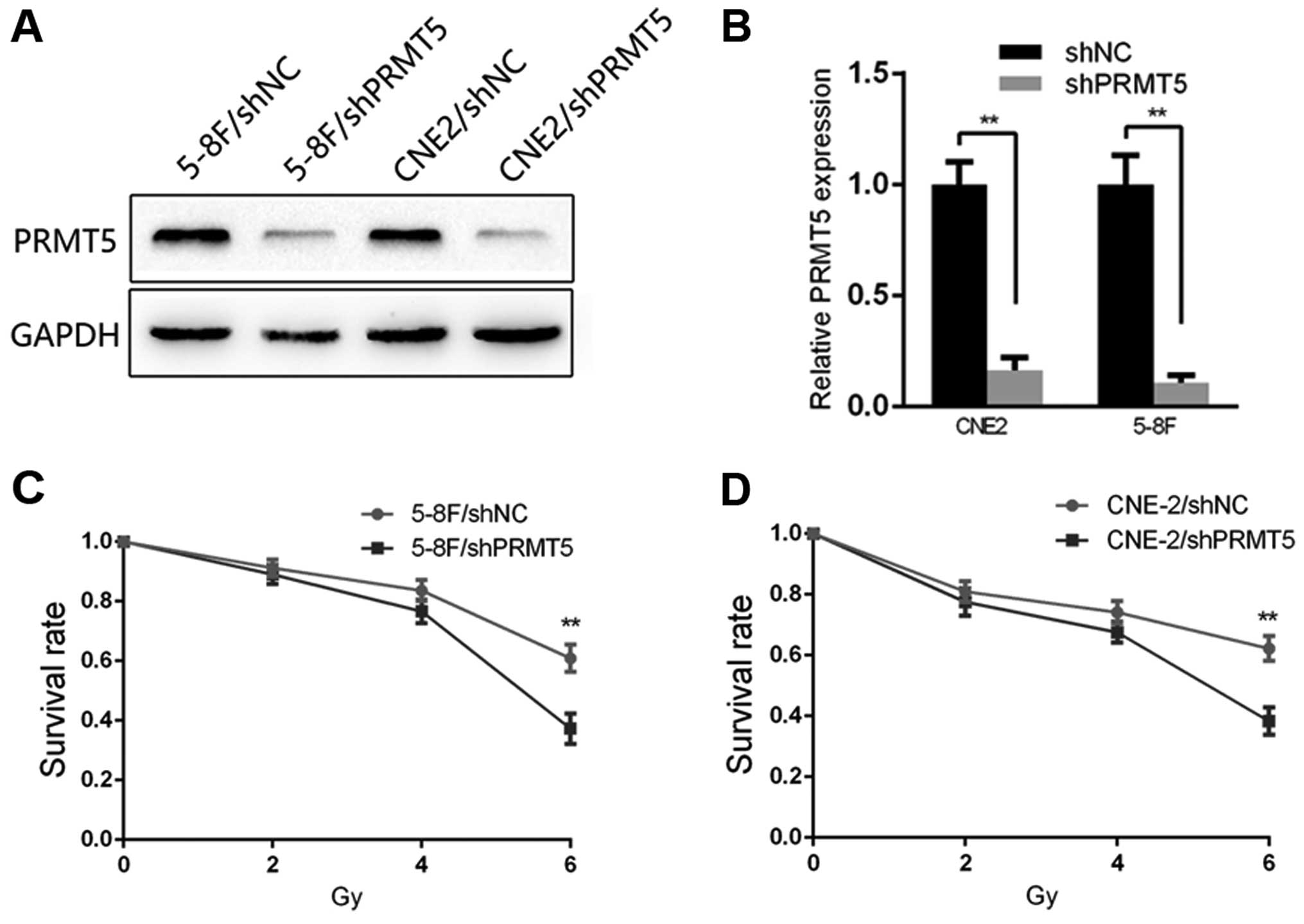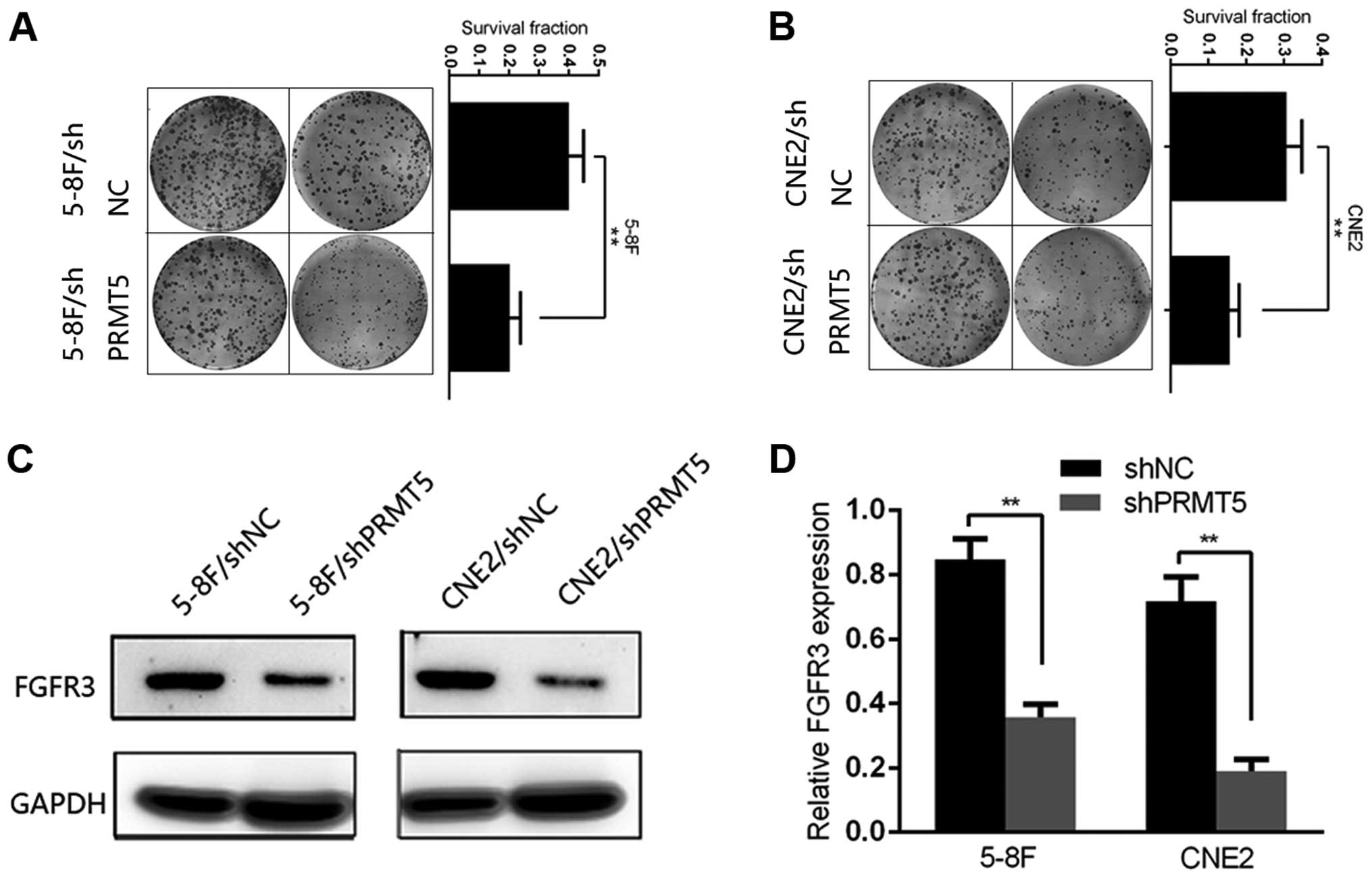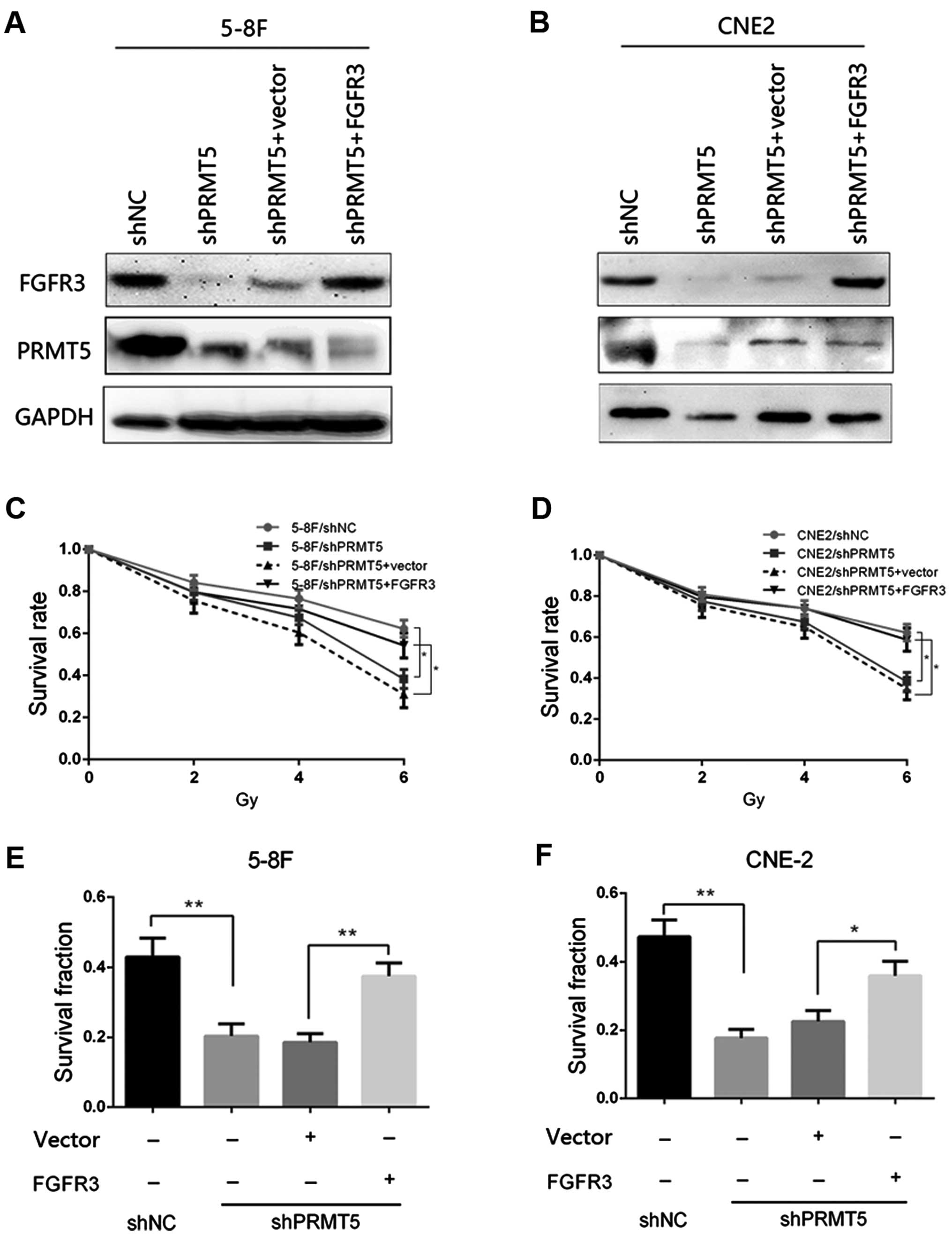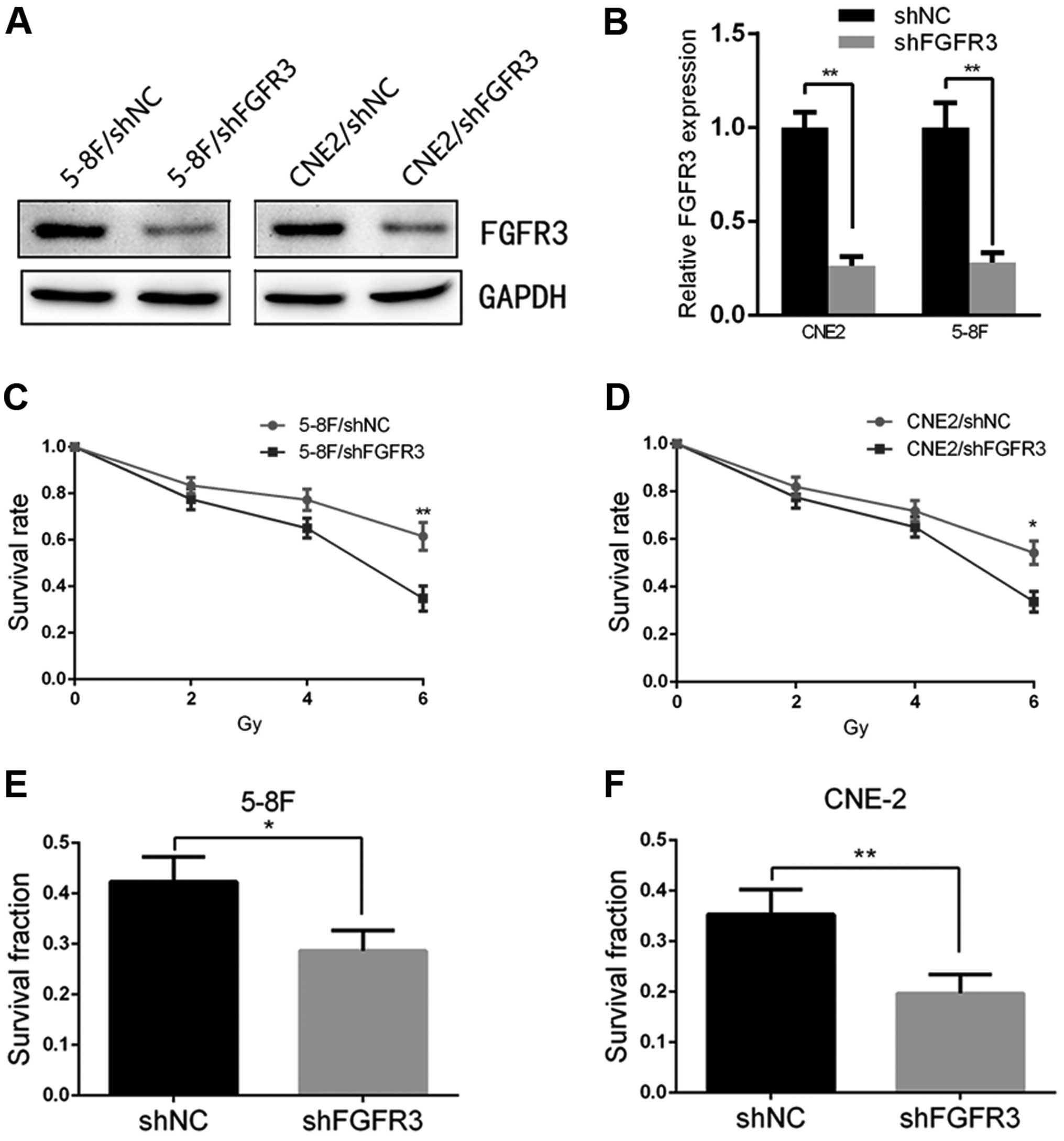Protein N-arginine methyltransferase 5 promotes the tumor progression and radioresistance of nasopharyngeal carcinoma
- Authors:
- Published online on: December 24, 2015 https://doi.org/10.3892/or.2015.4513
- Pages: 1703-1710
Abstract
Introduction
Nasopharyngeal carcinoma (NPC) is the most common type of head and neck cancer with significant regional differences (1). The annual incidence of NPC in regions of Southeast Asian is much higher than that of other regions worldwide (2,3). Genetic factors, EB virus infection, environmental factors and diet are all possible related etiologies of NPC, while the molecular characteristics and biological behaviors of NPC remain elusive (4–7). Radiation therapy, surgical treatment and chemotherapy are all conventional treatment options for NPC patients and the majority of early stage NPC patients achieve long-term survival with standardized radiation therapy (8,9). However, more than 15% of NPC patients suffer from recurrence due to radioresistance while the exact mechanism behind this remains elusive (8,10).
Histone modification, a post-translational modification process including methylation, phosphorylation, acetylation, ubiquitination and ADP-ribosylation, can alter the chromatin state or alter the binding affinity of transcription factors to DNA and thus affect gene expression (11,12). Both arginine and lysine residues can be methylated. Methylated lysines are well known marks of the histone code, and the methylation status of specific lysines is able to determine gene expression states (13). Methylation of lysines H3K4 and H3K36 can transcriptionally activate gene expression while methylation of H3-K9, H3-K27 and H4-K20 always inhibits gene transcription (14–16). In regards to arginine methylation, two categories of protein N-arginine methyltransferases (PRMTs) have been identified; protein arginine methyltransferase 5 (PRMT5) is responsible for the mono- and symmetric-dimethylation of arginine and all other PRMTs (PRMT1, PRMT3, RMT1/HMT and PRMT4/CAMR1) mainly account for the asymmetric dimethylation of arginine (17,18). Recently, the role of PRMT5 in controlling cell proliferation and signaling transduction has been identified. Knockout of PRMT5 in mice was found to induce early embryonic lethality (19). Furthermore, PRMT5 regulates cell apoptosis by affecting the activity of p53, a well-established tumor suppressor involved in multiple biological processes (20). In human lung adenocarcinoma, PRMT5 was found to be correlated with vessel invasion and regulated epithelial-mesenchymal transition of lung cancer cells (21). Silencing of PRMT5 in colorectal cancer cells was able to decrease the arginine methylation of eIF4E and fibroblast growth factor receptor 3 (FGFR3) and thus inhibit colorectal cancer growth (22). Although PRMT5 has been implicated in various human tumors, the expression level of PRMT5 in human NPC cell lines and tissue samples has not been previously reprted. In the present study, we aimed to explore the clinical significance of PRMT5 in NPC tissues and the biological role, particularly radioresistance-related mechanisms of PRMT5 in NPC cells.
Materials and methods
Patients and follow-up
All specimens were obtained following the informed consent of patients prior to surgery. All human and animal studies were approved by the Ethics Committee of The First Affiliated Hospital of Zhengzhou University, Zhengzhou University School of Medicine, and were therefore performed in accordance with the ethical standards laid down in the 1964 Declaration of Helsinki and its later amendments. One hundred and twelve NPC patients were enrolled in the present study, between December 2008 and February 2010. Follow-up data were summarized in 2015, and the patients were evaluated every 2–3 months during the first 2 years and every 3–6 months thereafter. The overall survival (OS) was calculated from the date of resection to the date of death or last follow-up.
One hundred and twelve NPCs of different stages were used to construct a tissue microarray. The tissue microarray was stained for PRMT5 (Abcam, USA) expression. Scoring was performed by two researchers independently. The number of stained cells was counted and scored as 0 (no staining), 1 (1–25%), 2 (26–50%) and 3 (>50%) accordingly. Staining intensity was scored as 0 (no staining), 1 (weak staining), 2 (moderate staining) and 3 (strong staining). The final score was obtained by multiplying the score for the number of stained cells with the staining intensity score providing a final range of 0–9. Specimens scoring 0–1 were considered as having low expression, 2 and 3 represent moderate expression and scoring of 4–9 was regarded as high expression.
Cell culture and lentivirus production
Human NPC cell lines TW06, CNE1, 5-8F and CNE2, and the immortalized nasopharyngeal epithelial cell line NP69 were obtained from the Cell Bank of the Type Culture Collection of the Chinese Academy of Sciences (Shanghai, China) and conserved in our laboratory. All cells were cultured in Dulbecco's modified Eagle's medium (DMEM) containing 10% fetal bovine serum (FBS; Gibco, Australia) at 37°C with 5% CO2. Lentiviruses expressing shPRMT5, shFGFR3 or shNC were purchased from GeneChem (Shanghai, China). The effective short hairpin RNA (shRNA) targeted against the sequence in the coding region of the human PRMT5 gene was: 5′-GGATAA AGCTGTATGCTGT-3′. 5-8F and CNE2 cells (1×105) were plated in 6-well plates and transfected with the lentiviruses according to the manufacturer's protocol. Stable cell lines were obtained by continuous selection by puromycin. The sequences of the shRNAs are presented in Table I.
Quantitative RT-PCR
Total RNA was extracted by TRIzol reagent (Invitrogen). Reverse transcription was performed using the ReverTra Ace qPCR RT kit (Toyobo, Osaka, Japan) according to the manufacturer's protocol. In regards to the real-time PCR analysis, aliquots of double-stranded cDNA were amplified using SYBR®-Green Real-Time PCR Master Mix (Toyobo). The relative expression levels (fold-change) of the target genes were determined by the 2−ΔΔCt (ΔCt = Cttarget - CtGAPDH; ΔΔCt = ΔCtexpressing vector - ΔCtcontrol vector) method. The primer sequences are listed in Table I.
Transient transfection
In regards to the transient transfection, cells were plated into 6-well plates at a density of 3×105 cells/well and transfected with pcDNA3.1-FGFR3 or control plasmids and Lipofectamine 2000 (Invitrogen, Carlsbad, CA, USA) according to the manufacturer's instructions. Quantitative RT-PCR and immunoblotting were used to ensure effective transfection efficiency. All functional studies were performed after transfection for 48 h.
Cell proliferation assay
6-MV X-rays from a linear accelerator (Varian-2300EX; Varian, Palo Alto, CA, USA) were used at a dose rate of 3 Gy/min. Cell Counting Kit-8 (CCK-8) (Dojindo) was employed for cell proliferation assay according to the manufacturer's instructions. Cells were plated in 96-well cell plates at a density of 1,500 cells/well and incubated for 12 h. Then, cells of each group were treated with the indicated doses of radiation according to the aim of the experiment. Optical density (OD) values at 450 nm were recorded by a microplate reader (Epoch; BioTek), and each experiment was performed in triplicate and then averaged.
Colony formation assay
The plate colony formation assay was performed according to previous studies (23,24). Logarithmic growth phase cells in each group were incubated in 6-well plates at a density of 1,000 cells/well for 12 h. Subsequently the cells were exposed to ionizing radiation (IR) with a dose of 6 Gy and incubated for another 14 days. The surviving colonies (colonies containing >50 cells) were counted by microscopic inspection in three independent experiments.
Immunoblotting assay
For the immunoblotting analysis, NPC tissues/cells were digested in RIPA (Solarbio, China) buffer in the presence of protease inhibitor cocktail (Sigma, USA). Protein concentration was detected by the Bradford assay according to the manufacturer's protocol. Then, total protein was transferred to PVDF membranes (Millipore, Billerica, MA, USA). The membranes were blocked in 5% milk for 2 h at room temperature and incubated with the antibody overnight at 4°C. The primary antibodies used were rabbit anti-PRMT5, rabbit anti-FGFR3 (both from Abcam) and rabbit anti-GAPDH, and the secondary antibodies were horseradish peroxidase (HRP)-conjugated secondary anti-rabbit antibody (both from Cell Signaling Technology, Danvers, MA, USA). Pierce ECL Plus Substrate (Thermo Scientific, USA) was employed for the western blotting visualization.
Statistical analysis
The software Microsoft Excel and SPSS 18.0 (SPSS Inc., Chicago, IL, USA) were used for statistical analysis. t-test and one-way ANOVA analysis were used for analyzing the difference in measured data while the appropriate. χ2 test was used for evaluating the difference in categorical data. Survival curves (Kaplan-Meier) and log-rank test were used to assess the survival status of the different groups.
Results
Elevated PRMT5 expression in NPC patients is correlated with a poor prognosis
We first evaluated the mRNA level of PRMT5 in 46 paired NPC and corresponding normal tissues by quantitative RT-PCR. The expression level of PRMT5 in the NPC tissues was significantly higher than that in the adjacent non-tumor tissues, which indicated the potential oncogenic role of PRMT5 in NPC patients (Fig. 1A). Furthermore, we confirmed this difference by immunoblotting analysis of 4 pairs of NPC cases (Fig. 1B). We then investigated the expression of PRMT5 in the NPC cell lines at the RNA level. Notably, PRMT5 was also upregulated in a panel of cancer cell lines compared with its expression in the NP69 cells, an immortalized nasopharyngeal epithelial cell line (Fig. 1C). We next evaluated the clinical role of PRMT5 in NPC. A tissue microarray containing 112 cases was conducted for evaluating the relationship between the PRMT5 level and clinicopathological parameters of NPC patients. Representative images are presented in Fig. 1D and E. By scoring the results of our tissue microarray, we found that the nuclear but not the cytoplasmic PRMT5 level was correlated with a poorer tumor stage and lymph nodal status, and the relationship between PRMT5 expression and the clinicopathological parameters of the NPC patients is summarized in Table II. The 5-year OS (Fig. 1F) indicated that a high nuclear PRMT5 expression level in the NPC patients predicted poorer outcomes when compared to the outcome of patients with low expression. All of these results revealed the clinical significance of PRMT5 in NPC patients.
Table IIAssociation between expression of PRMT5 and clinicopathological features of the NPC cases (n=112). |
Silencing of PRMT5 in NPC cell lines increases radiosensitivity
To gain a more comprehensive understanding of the effect of PRMT5 on radiosensitivity, we generated 5-8F and CNE2 cell lines expressing shPRMT5 (5-8F/shPRMT5 and CNE2/shPRMT5) and the corresponding negative control cells (5-8F/shNC and CNE2/shNC). The transfection efficiency of 5-8F and CNE2 was confirmed by qRT-PCR and immunoblotting, respectively. The result of qRT-PCR showed a significant interference effect at the RNA level in both cell lines, and the result of immunoblotting showed an effective interference effect at the protein level (Fig. 2A and B). Based on the clinical role and differential expression of PRMT5 in the NPC cells, we explored the potential significance of PRMT5 in NPC radioresistance. The results of the CCK-8 assay revealed that following 2, 4 and 6 Gy irradiation stimulation, the survival rate of the 5-8F/shPRMT5 cells was decreased compared with that of the 5-8F/shNC cells (Fig. 2C). A similar result was observed in the CNE2 cells (Fig. 2D).
FGFR3 is a major downstream effector of PRMT5 in NPC cell lines
We next conducted plate colony formation assay to investigate the colony formation ability of each group. 5-8F and CNE2 cells of each group were plated in a 6-well plate and incubated for 14 days after irradiation exposure at a dose of 6 Gy. Cells transfected with shNC showed a significant colony formation advantage over the shPRMT5 group and the survival fraction was decreased in the 5-8F/shPRMT5 and CNE2/shPRMT5 cells compared with that noted in the 5-8F/shNC and CNE2/shNC cells, respectively (Fig. 3A and B). Then, we explored the potential mechanisms of PRMT5-induced radioresistance. FGFR3 has been identified as a major downstream effector through which PRMT5 regulates tumor progression in lung and colorectal cancer. In the present study, we tentatively examined the protein level of FGFR3 in the shPRMT5 and shNC cells. Notably, we found that the protein level of FGFR3 was significantly decreased after silencing of PRMT5 in the 5-8F and CNE2 cells (Fig. 3C). To better understand the relationship between PRMT5 and FGFR3 in the NPC cells, we detected the mRNA levels and luciferase activity of FGFR3 in the two group of 5-8F and CNE2 cells. As a result, the change in the mRNA level of FGFR3 was in accordance with the protein level in both cell lines (Fig. 3D).
Overexpression of FGFR3 restores PRMT5 silenced-induced radiosensitivity
Given that FGFR3 is a downstream target of PRMT5 in NPC cells, we then investigated whether FGFR3 restoration in the 5-8F/shPRMT5 and CNE2/shPRMT5 cells could reverse the phenotypes induced by PRMT5 silencing. The FGFR3-overexpressing vector pcDNA3.1-FGFR3 and corresponding control plasmids were transfected into the 5-8F/shPRMT5 and CNE2/shPRMT5 cells, respectively. The transfection effect was confirmed by immunoblotting and the results are presented in Fig. 4A and B. We found that re-expression of FGFR3 in the 5-8F/shPRMT5 and CNE2/shPRMT5 cells increased the survival rate of both cell lines to similar levels as observed in the 5-8F/shNC and CNE2/shNC cells as determined by CCK-8 analysis (Fig. 4C and D). Furthermore, FGFR3 restoration in the 5-8F/shPRMT5 and CNE2/shPRMT5 cells increased the survival fraction by colony formation analysis compared with that of the 5-8F/shPRMT5 and CNE2/shPRMT5 cells transfected with the vector plasmids (Fig. 4E and F). Taken together, these results suggest that FGFR3 expression could restore the radiosensitivity induced by PRMT5 silencing in the 5-8F and CNE2 cells.
Silencing of FGFR3 in the NPC cell lines increases radiosensitivity
Finally, to demonstrate the potential of the FGFR3-mediated regulation of cell radiosensitivity, we transfected shRNAs targeting FGFR3 and a negative control into 5-8F and CNE2 cells, respectively. The results of the qRT-PCR and immunoblotting showed that the 5-8F and CNE2 cells transfected with shFGFR3 yielded a significant downregulation of FGFR3 compared with the 5-8F/shNC and CNE2/shNC cells (Fig. 5A and B). We observed that the silencing of FGFR3 in the 5-8F and CNE2 cells significantly decreased the survival rate to similar levels as observed in the 5-8F/shPRMT5 and CNE2/shPRMT5 cells as determined by CCK-8 analysis (Fig. 5C and D). In addition, inhibition of FGFR3 also reduced the survival fraction of both cell lines by colony formation assay (Fig. 5E and F). These results were similar to the effects of silencing PRMT5 in NPC cells.
Discussion
Radioresistance is a major cause for the poor prognosis of NPC patients (25). Recently, biological and clinical studies have focused on the molecular characteristics and biological behaviors of NPC, particularly on the mechanisms of radioresistance: i) genetic changes including chromosome alteration and gene mutation (4,26); ii) ectopic expression of protein kinases, epigenetic-related enzymes and DNA repair proteins (27,28); iii) overactivation of signaling pathways including ERK, PI3K/AKT, Wnt and NF-kB (23,29–32). All of these changes may finally induce proliferation, apoptosis, angiogenesis and autophagy. Although many efforts have been made to investigate the mechanisms of radioresistance in previous studies, there is still an urgent need for screening novel molecular targets attibuted to the radioresistance of NPC. Recently, a relationship between the aggressive behaviors of NPC and the nucleosome remodeling complex SWI/SNF (SWItch/sucrose non-fermentable) has attacted much attention. The overexpression of Rsf-1, a chromatin remodeling protein, was correlated with poor therapeutic response and adverse outcomes of NPC patients (33). Furthermore, a mutational landscape of 128 cases conducted by Lin et al provided a comprehensive understanding of the genetic changes of NPC (26). These studies revealed a preliminary relationship between the remodeling complex SWI/SNF and the NPC malignant phenotype, which warrants further research.
In the present study, we found that PRMT5, a member of the SWI/SNF complex, was overexpressed in NPC tissues and cell lines compared with its levels in adjacent non-tumor tissues and the immortalized nasopharyngeal epithelial NP69 cell line, which indicated the potential oncogenic role of PRMT5 in NPC patients. Next, we conducted a tissue microarray containing 112 NPC cases to evaluate the clinical significance of PRMT5 in NPC tissues. By scoring the staining result and Kaplan-Meier survival analysis, we found that high expression of PRMT5 in NPC tissues predicted a poorer survival rate of the NPC patients. Furthermore, a higher level of PRMT5 was correlated with a more advanced tumor stage and adverse lymph nodal status of NPC patients. Given the clinical significance of PRMT5 in NPC tissues, we next explored the biological role of PRMT5 in NPC cells and the potential mechanisms. We generated stable cell lines transfected with shPRMT5 and shNC to compare the radiosensitivity of the two cell groups in the 5-8F and CNE2 cells. The results of the CCK-8 assay showed that the silencing of PRMT5 in the 5-8F and CNE2 cells could increase the radiosensitivity and the result was confirmed by a colony formation analysis. These results indicated that PRMT5-mediated radioresistance may be responsible for the poor prognosis of some NPC patients.
We next explored the mechanisms by which PRMT5 regulates the radiosensitivity of NPC cells. FGFR3 was identified as a target of PRMT5 in lung and colorectal cancer (22,34). In the present study, the protein level of FGFR3 was decreased after silencing of PRMT5 in the 5-8F and CNE2 cells, which was verified at the mRNA level and by luciferase activity change. The chromatin immunoprecipitation (ChIP) results of previous studies revealed that FGFR3 and eIF4E are two critical downstream genes regulated by PRMT5. Our present study also identified that PRMT5 could transcriptionally activate FGFR3 expression. Furthermore, silencing of FGFR3 induced similar phenotypes as PRMT5 inhibition, and re-expression of FGFR3 in the 5-8F/shPRMT5 and CNE2/shPRMT5 cells increased the radiosensitivity of cells as determined by CCK-8 and colony formation assays. Taken together, PRMT5 regulates the apoptosis-dependent radiosensitivity of NPC cells via targeting FGFR3.
In conclusion, the present study demonstrated the clinical significance of PRMT5 expression in NPC tissues. PRMT5 plays an important role in the enhancement of radiosensitivity in NPC cells, and FGFR3 is a downstream effector of PRMT5-induced radioresistance. The PRMT5-FGFR3 axis may be a potential therapeutic target for NPC patients.
Acknowledgments
The present study was supported by the Second Batch of Science and Technology Projects of Henan Province (142102310055).
References
|
Wei WI and Sham JS: Nasopharyngeal carcinoma. Lancet. 365:2041–2054. 2005. View Article : Google Scholar : PubMed/NCBI | |
|
Guo P, Huang ZL, Yu P and Li K: Trends in cancer mortality in China: An update. Ann Oncol. 23:2755–2762. 2012. View Article : Google Scholar : PubMed/NCBI | |
|
Torre LA, Bray F, Siegel RL, Ferlay J, Lortet-Tieulent J and Jemal A: Global cancer statistics, 2012. CA Cancer J Clin. 65:87–108. 2015. View Article : Google Scholar : PubMed/NCBI | |
|
Lo KW, Chung GT and To KF: Acquired genetic and epigenetic alterations in nasopharyngeal carcinoma. Nasopharyngeal Carcinoma. Busson P: Springer; New York: pp. 61–81. 2013, View Article : Google Scholar | |
|
Hildesheim A and Wang CP: Genetic predisposition factors and nasopharyngeal carcinoma risk: A review of epidemiological association studies, 2000–2011: Rosetta Stone for NPC: Genetics, viral infection, and other environmental factors. Semin Cancer Biol. 22:107–116. 2012. View Article : Google Scholar : PubMed/NCBI | |
|
West RB: Fingerprints of Epstein-Barr virus in nasopharyngeal carcinoma. Nat Genet. 46:809–810. 2014. View Article : Google Scholar : PubMed/NCBI | |
|
Polesel J, Serraino D, Negri E, Barzan L, Vaccher E, Montella M, Zucchetto A, Garavello W, Franceschi S, La Vecchia C, et al: Consumption of fruit, vegetables, and other food groups and the risk of nasopharyngeal carcinoma. Cancer Causes Control. 24:1157–1165. 2013. View Article : Google Scholar : PubMed/NCBI | |
|
Yoshizaki T, Ito M, Murono S, Wakisaka N, Kondo S and Endo K: Current understanding and management of nasopharyngeal carcinoma. Auris Nasus Larynx. 39:137–144. 2012. View Article : Google Scholar | |
|
Bensouda Y, Kaikani W, Ahbeddou N, Rahhali R, Jabri M, Mrabti H, Boussen H and Errihani H: Treatment for metastatic nasopharyngeal carcinoma. Eur Ann Otorhinolaryngol Head Neck Dis. 128:79–85. 2011. View Article : Google Scholar | |
|
Yu F and Loh KS: Cancer stem cells in nasopharyngeal carcinoma: Current evidence. JNPC. 1:e62014. View Article : Google Scholar | |
|
Zentner GE and Henikoff S: Regulation of nucleosome dynamics by histone modifications. Nat Struct Mol Biol. 20:259–266. 2013. View Article : Google Scholar : PubMed/NCBI | |
|
Waldmann T and Schneider R: Targeting histone modifications - epigenetics in cancer. Curr Opin Cell Biol. 25:184–189. 2013. View Article : Google Scholar : PubMed/NCBI | |
|
Greer EL and Shi Y: Histone methylation: A dynamic mark in health, disease and inheritance. Nat Rev Genet. 13:343–357. 2012. View Article : Google Scholar : PubMed/NCBI | |
|
Chung S, Sundar I, Rahman I and Yao H: Cigarette smoke causes a residue-specific histone methylation and its cross-talk with histone acetylation in human lung epithelial cells. Am J Respir Crit Care Med. 185:A34742012. | |
|
Eram MS, Bustos SP, Lima-Fernandes E, Siarheyeva A, Senisterra G, Hajian T, Chau I, Duan S, Wu H, Dombrovski L, et al: Trimethylation of histone H3 lysine 36 by human methyltransferase PRDM9 protein. J Biol Chem. 289:12177–12188. 2014. View Article : Google Scholar : PubMed/NCBI | |
|
Tang H, Fang H, Yin E, Brasier AR, Sowers LC and Zhang K: Multiplexed parallel reaction monitoring targeting histone modifications on the QExactive mass spectrometer. Anal Chem. 86:5526–5534. 2014. View Article : Google Scholar : PubMed/NCBI | |
|
Di Lorenzo A and Bedford MT: Histone arginine methylation. FEBS Lett. 585:2024–2031. 2011. View Article : Google Scholar | |
|
Berrens RV and Reik W: Prmt5: A guardian of the germline protects future generations. EMBO J. 34:689–690. 2015. View Article : Google Scholar : PubMed/NCBI | |
|
Kim S, Günesdogan U, Zylicz JJ, Hackett JA, Cougot D, Bao S, Lee C, Dietmann S, Allen GE, Sengupta R, et al: PRMT5 protects genomic integrity during global DNA demethylation in primordial germ cells and preimplantation embryos. Mol Cell. 56:564–579. 2014. View Article : Google Scholar : PubMed/NCBI | |
|
Chu Z, Niu B, Zhu H, He X, Bai C, Li G and Hua J: PRMT5 enhances generation of induced pluripotent stem cells from dairy goat embryonic fibroblasts via down-regulation of p53. Cell Prolif. 48:29–38. 2015. View Article : Google Scholar | |
|
Ibrahim R, Matsubara D, Osman W, Morikawa T, Goto A, Morita S, Ishikawa S, Aburatani H, Takai D, Nakajima J, et al: Expression of PRMT5 in lung adenocarcinoma and its significance in epithelial-mesenchymal transition. Hum Pathol. 45:1397–1405. 2014. View Article : Google Scholar : PubMed/NCBI | |
|
Zhang B, Dong S, Zhu R, Hu C, Hou J, Li Y, Zhao Q, Shao X, Bu Q, Li H, et al: Targeting protein arginine methyltransferase 5 inhibits colorectal cancer growth by decreasing arginine methylation of eIF4E and FGFR3. Oncotarget. 6:22799–22811. 2015. View Article : Google Scholar : PubMed/NCBI | |
|
Li G, Liu Y, Su Z, Ren S, Zhu G, Tian Y and Qiu Y: MicroRNA-324-3p regulates nasopharyngeal carcinoma radioresistance by directly targeting WNT2B. Eur J Cancer. 49:2596–2607. 2013. View Article : Google Scholar : PubMed/NCBI | |
|
Li G, Wang Y, Liu Y, Su Z, Liu C, Ren S, Deng T, Huang D, Tian Y and Qiu Y: miR-185-3p regulates nasopharyngeal carcinoma radioresistance by targeting WNT2B in vitro. Cancer Sci. 105:1560–1568. 2014. View Article : Google Scholar : PubMed/NCBI | |
|
Chua DT, Nicholls JM, Sham JS and Au GK: Prognostic value of epidermal growth factor receptor expression in patients with advanced stage nasopharyngeal carcinoma treated with induction chemotherapy and radiotherapy. Int J Radiat Oncol Biol Phys. 59:11–20. 2004. View Article : Google Scholar : PubMed/NCBI | |
|
Lin DC, Meng X, Hazawa M, Nagata Y, Varela AM, Xu L, Sato Y, Liu LZ, Ding LW, Sharma A, et al: The genomic landscape of nasopharyngeal carcinoma. Nat Genet. 46:866–871. 2014. View Article : Google Scholar : PubMed/NCBI | |
|
Yang F, Qian X-J, Qin W, Deng R, Wu XQ, Qin J, Feng GK and Zhu XF: Dual phosphoinositide 3-kinase/mammalian target of rapamycin inhibitor NVP-BEZ235 has a therapeutic potential and sensitizes cisplatin in nasopharyngeal carcinoma. PLoS One. 8:e598792013. View Article : Google Scholar : PubMed/NCBI | |
|
Pan Y, Zhang Q, Atsaves V, Yang H and Claret FX: Suppression of Jab1/CSN5 induces radio- and chemo-sensitivity in nasopharyngeal carcinoma through changes to the DNA damage and repair pathways. Oncogene. 32:2756–2766. 2013. View Article : Google Scholar : | |
|
Agaoglu FY, Dizdar Y, Dogan O, Alatli C, Ayan I, Savci N, Tas S, Dalay N and Altun M: p53 overexpression in nasopharyngeal carcinoma. In Vivo. 18:555–560. 2004.PubMed/NCBI | |
|
Dolcet X, Llobet D, Pallares J and Matias-Guiu X: NF-kB in development and progression of human cancer. Virchows Arch. 446:475–482. 2005. View Article : Google Scholar : PubMed/NCBI | |
|
Shi D, Guo W, Chen W, Fu L, Wang J, Tian Y, Xiao X, Kang T, Huang W and Deng W: Nicotine promotes proliferation of human nasopharyngeal carcinoma cells by regulating α7AChR, ERK, HIF-1α and VEGF/PEDF signaling. PLoS One. 7:e438982012. View Article : Google Scholar | |
|
Liu Y, Chen LH, Yuan YW, Li QS, Sun AM and Guan J: Activation of AKT is associated with metastasis of nasopharyngeal carcinoma. Tumour Biol. 33:241–245. 2012. View Article : Google Scholar | |
|
Tai HC, Huang HY, Lee SW, Lin CY, Sheu MJ, Chang SL, Wu LC, Shiue YL, Wu WR, Lin CM, et al: Associations of Rsf-1 overexpression with poor therapeutic response and worse survival in patients with nasopharyngeal carcinoma. J Clin Pathol. 65:248–253. 2012. View Article : Google Scholar | |
|
Gu Z, Gao S, Zhang F and Wang Z, Ma W, Davis RE and Wang Z: Protein arginine methyltransferase 5 is essential for growth of lung cancer cells. Biochem J. 446:235–241. 2012. View Article : Google Scholar : PubMed/NCBI |



